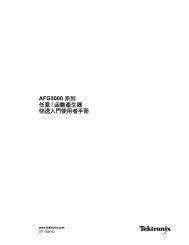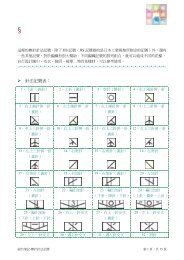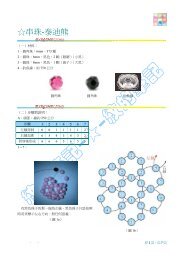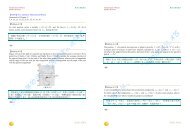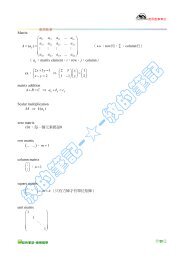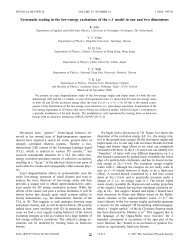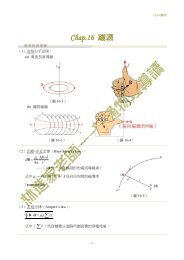Chapter 22 Materials Selection and Design Considerations
Chapter 22 Materials Selection and Design Considerations
Chapter 22 Materials Selection and Design Considerations
You also want an ePaper? Increase the reach of your titles
YUMPU automatically turns print PDFs into web optimized ePapers that Google loves.
DESIGN QUESTIONS AND PROBLEMS<br />
Solving of some problems in this chapter may be<br />
expedited by using the “Engineering <strong>Materials</strong><br />
Properties” component of VMSE found on the<br />
book’s Web site [www.wiley.com/college/callister<br />
(Student Companion Site).] We have noted these<br />
specific problems by inclusion of the following<br />
icon in one of the margins by the problem<br />
statement:<br />
<strong>Materials</strong> <strong>Selection</strong> Using Performance Indices<br />
<strong>22</strong>.D1 (a) Using the procedure as outlined in Section<br />
<strong>22</strong>.2 ascertain which of the metal alloys<br />
listed in Appendix B have torsional<br />
strength performance indices greater than<br />
10.0 (for <strong>and</strong> in units of MPa <strong>and</strong><br />
g/cm 3 tf r<br />
, respectively), <strong>and</strong>, in addition, shear<br />
strengths greater than 350 MPa. (b) Also<br />
using the cost database (Appendix C), conduct<br />
a cost analysis in the same manner as<br />
Section <strong>22</strong>.2. For those materials that satisfy<br />
the criteria noted in part a, <strong>and</strong>, on the<br />
basis of this cost analysis, which material<br />
would you select for a solid cylindrical<br />
shaft? Why?<br />
<strong>22</strong>.D2 In a manner similar to the treatment of<br />
Section <strong>22</strong>.2, perform a stiffness-to-mass<br />
performance analysis on a solid cylindrical<br />
shaft that is subjected to a torsional stress.<br />
Use the same engineering materials that<br />
are listed in Table <strong>22</strong>.1. In addition, conduct<br />
a material cost analysis. Rank these<br />
materials both on the basis of mass of material<br />
required <strong>and</strong> material cost. For glass<br />
<strong>and</strong> carbon fiber-reinforced composites,<br />
assume that the shear moduli are 8.6 <strong>and</strong><br />
9.2 GPa, respectively.<br />
<strong>22</strong>.D3 (a) A cylindrical cantilever beam is subjected<br />
to a force F, as indicated in the figure<br />
below. Derive strength <strong>and</strong> stiffness<br />
performance index expressions analogous<br />
to Equations <strong>22</strong>.9 <strong>and</strong> <strong>22</strong>.11 for this beam.<br />
The stress imposed on the unfixed end s is<br />
s � FLr<br />
I<br />
(<strong>22</strong>.30)<br />
L, r, <strong>and</strong> I are, respectively, the length,<br />
radius, <strong>and</strong> moment of inertia of the<br />
<strong>Design</strong> Questions <strong>and</strong> Problems • W131<br />
beam. Furthermore, the beam-end deflection<br />
d is<br />
d � FL3<br />
3 EI<br />
(<strong>22</strong>.31)<br />
where E is the modulus of elasticity of the<br />
beam.<br />
(b) From the properties database presented<br />
in Appendix B, select those metal<br />
alloys with stiffness performance indices<br />
greater that 3.0 (for E <strong>and</strong> in units of<br />
GPa <strong>and</strong> g/cm 3 r<br />
, respectively).<br />
(c) Also using the cost database (Appendix<br />
C), conduct a cost analysis in the same manner<br />
as Section <strong>22</strong>.2. Relative to this analysis<br />
<strong>and</strong> that in part b, which alloy would you select<br />
on a stiffness-per-mass basis?<br />
(d) Now select those metal alloys having<br />
strength performance indices greater than<br />
14.0 (for <strong>and</strong> in units of MPa <strong>and</strong> g/cm 3 sy r<br />
,<br />
respectively), <strong>and</strong> rank them from highest<br />
to lowest P.<br />
(e) And, using the cost database, rank the<br />
materials in part d from least to most<br />
costly. Relative to this analysis <strong>and</strong> that in<br />
part d, which alloy would you select on a<br />
strength-per-mass basis?<br />
(f) Which material would you select if<br />
both stiffness <strong>and</strong> strength are to be considered<br />
relative to this application? Justify<br />
your choice.<br />
L<br />
r<br />
F<br />
δ



